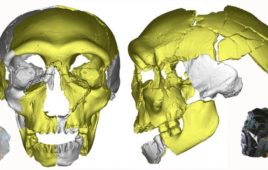JOHANNESBURG
(AP)—Poisoned-tipped arrows and jewelry made of ostrich egg beads found
in South Africa show modern culture may have emerged about 30,000 years
earlier in the area than previously thought, according to two articles
published on Monday.
The
findings published in the journal Proceedings of the National Academy
of Sciences show that the 44,000-year-old artifacts are characteristic
of the San hunter-gatherers. The descendants of San people live today in
southern Africa, so the items can clearly be traced forward to modern
culture, unlike other archaeological finds, researchers said.
South
African researcher Lucinda Backwell said the findings are the earliest
known instances of “modern behavior as we know it.” Backwell said the
discovery reinforces the theory that modern man came from southern
Africa.
The
carbon dating on the items shows that traces of the San culture may
have existed earlier than the previous estimate of somewhere between
10,000 and 20,000 years ago, the journal said.
The
find, discovered at Border Cave close to South Africa’s northeastern
border with Swaziland, is a comprehensive package of hunting kits and
jewelry made of ostrich egg and marine shell beads.
Backwell,
who was part of the team of international researchers that made the
find, said the artifacts created as many as 44,000 years ago served the
same purposes as they would today.
“They all have a specific reason we understand, that’s why we can name them,” Backwell said.
The
researchers’ articles said the Border Cave people used poisoned arrows
to hunt and put spiral engraving on arrowheads to indicate ownership.
The latter practice has been preserved in the San culture, they said.
Professor
Francesco d’Errico of the French National Research Centre, who led the
research team, said that the findings tell of a people who were highly
evolved.
“They were fully modern genetically and cognitively,” d’Errico said.
Their
cognitive development is evident in their symbolic behavior, the
professor said. The ostrich egg beads were not only ornaments, but
played a major role in bartering with neighboring groups, he said. That
practice continues today.
The
paper claimed that the fossils show that all modern culture came from
southern Africa, though the researchers acknowledged it remains
difficult to pinpoint where in history that modernity began.
Eric
Delson, a paleoanthropologist at Lehman College of the City University
of New York, said that while the testing used by the researchers to
determine the age of the fossils was very clear and reliable, the
findings didn’t support the idea that all modern human cultures are
connected to this find.
He said there is evidence that a modern culture already existed in Europe around the time the new find is dated.
“They say, ‘Modern human behavior first found!'” Delson said. “Well, not exactly.”
He did, however, applaud the research for finding the origins of one specific group of modern people.
Scientists
from Britain, France, Italy, Norway, South Africa and the U.S. all took
part in the research, helmed out of the University of Witwatersrand in
Johannesburg.
Source: The Associated Press





